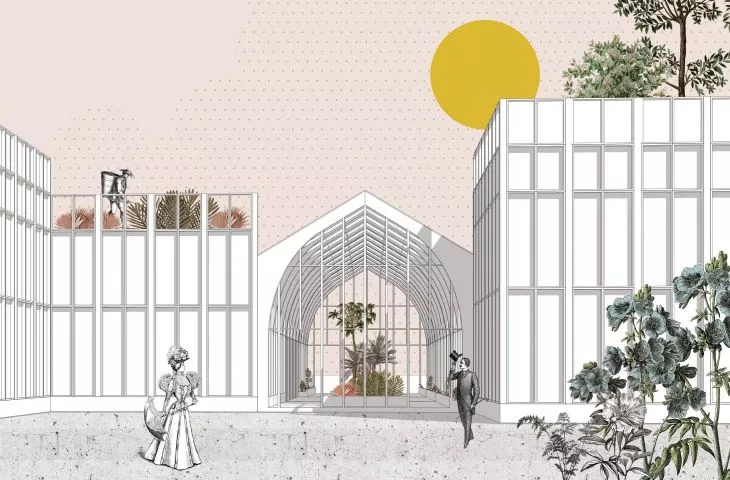Emilia Rakowska posing the question "Biophilia of the 21st century - a timeless necessity or a contemporary trend?" addressed the natural human need for contact with nature, considering it in terms of urban farming and recreational use of conservatories. This led to thedesign of urban farms and greenhouses for Warsaw residents.
Emilia Rakowska's project is a diploma thesis carried out at the Warsaw University of Technology under the direction of Karolina Tulkowska-Słyk, PhD. The concept won an honorable mention in the competition for the Warsaw Mayor's Award for the best thesis on the development of Warsaw. Since 2016, the city has been fostering the interest of young researchers in Warsaw by including them in the dialogue on the identity and development of the capital. The submitted works are a source of inspiration for the local government and are an important contribution to the way we think about the city.
A proposal for an urban growing facility in Warsaw
© Emilia Rakowska
urban farms and biophilia
Emilia Rakowska's diploma combines spatial issues and social, health and ecological issues. The issue of biophilia - man's natural need for contact with nature - raised by the author is considered in terms of urban farms and recreational use of conservatories.
As the author says about urban farms:
Urban farms are defined as the possibility of obtaining food products from crops and farms grown in urban areas. They take forms ranging from open space operations, specialized or crop-specific buildings, to pavilions and landscaping features. The recreational qualities of greenhouses, meanwhile, are being exploited in conservatories and design and furnishing elements - as green plant walls or home potting. The idea of urban cultiv ation is steadily gaining popularity, finding its way into the area of interest of many specialists and activists. A year after the completion of my project, it can be seen that the subject matter addressed is increasingly pressing. The epidemic situation in 2020 showed how dynamically changes can occur in the use of public spaces and the demand for local products. Urban residents in particular have felt the need to get in touch with nature and have realized the importance of social relations and the quality of the space they inhabit.
Greenery in the city: past, present and future
© Emilia Rakowska
As part of her diploma project, the author conducted an analysis of the aspects that determine the legitimacy, implementation and use of various forms of urban cultivation. She conducted the research with a view to determining the optimal characteristics and spatial guidelines for the introduction of crops to Warsaw, which could improve living conditions in the city.
Greenery in the city: past, present and future
The determinants of greenery and urban food production analyzed by the architect include premises that have been recurring since historical times, such as aesthetic and recreational needs, aspects related to spirituality and symbolism, and vertical social relations. The author also focused on the contemporary significance of greenery, namely horizontal social relations, health, environmental concerns, food production, economics and marketing activities. Emilia Rakowska also did not overlook the future and the projected growing popularity of urban crops in the coming years, taking into account the impact of new technologies and demographic changes.
The author has created a catalog of modules and a collection of types of plot development
© Emilia Rakowska
On the basis of these analyses, the graduate student of the Warsaw University of Technology proposed locations for cultivation in Warsaw, using ecological dependencies - distance from existing green areas, as well as communication, social and economic dependencies - ease of access for potential user groups, possibility of distributing surplus production. She also determined the spatial possibilities for the creation of a network of urban cultivation facilities, proposing the placement of crops next to blind walls, on flat roofs, underground or as part of the urban fabric complement.
The author then created a typology of spatial solutions, including a catalog of modules for recreational and industrial crops and a set of plot development types depending on local conditions, numerical parameters and preliminary design decisions. For the site's projection and volume solutions, she conducted multi-criteria optimization, taking into account the requirements of energy efficiency, the efficiency of industrial cultivation and the potential of soft benefits obtained.
The architect proposed an urban greenhouse in Warsaw's Mokotow district
© Emilia Rakowska
urban greenhouse in Mokotow
The research and conceptual work culminated in a design proposal in the Mokotow area. The chosen location allowed to present various spatial and functional scenarios of urban cultivation in Warsaw. The introduction of urban greenhouses would contribute to the activation of residents, the improvement of the quality of residential space and the development of business, services and technology, which are the main goals of Warsaw's development strategy until 2030 and in the long term. The development of green infrastructure would also make it possible to use the potential of existing allotment and community gardens.






































